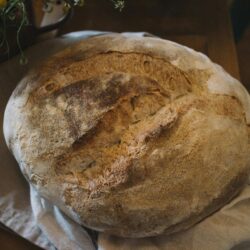
Sourdough Bread
Making sourdough bread can be a bit involved but definitely rewarding. Here's a straightforward recipe to get you started. Note that you'll need a sourdough starter, which you can either make yourself or get from a friend or bakery.
Equipment
- Large mixing bowl
- Wooden spoon or spatula
- Kitchen scale optional but helpful
- Proofing basket optional, you can usea bowl lined with a floured cloth
- Dutch oven or baking sheet
Ingredients
The Sourdough Starter
- 120 ml Water
- 60 g All-purpose flour
- 1 tbsp Whole grain flour optional, helps withstarter activity
- 60 g Active sourdough starter if you’re using onefrom another source
The Bread:
- 240 ml sourdough starter active and bubbly
- 360 ml Water
- 480 g All-purpose flour
- 0.5 tbsp Salt
Instructions
1. Feed the Starter:
- If you’re using a dry starter, mix 1/2 cup water, 1/2 cup all-purpose flour, and 1 tablespoon whole grain flour (optional) in a jar. Let it sit at room temperature for about 24 hours. If you have a starter that's been refrigerated, bring it to room temperature and feed it with equal parts water and flour.
2. Prepare the Dough:
- In a large mixing bowl, combine the 1 cup of sourdough starter with 1 1/2 cups of water. Stir until the starter is dissolved.
- Add 4 cups ofall-purpose flour and 1 1/2 teaspoons of salt to the bowl. Mix until a shaggydough forms.
3. Knead the Dough:
- Turn the dough out onto a floured surface. Knead the dough for about 8-10 minutes until it becomes smooth and elastic. You can also use a stand mixer with a dough hook to do this step.
4. First Rise (Bulk Fermentation):
- Place the dough in a lightly oiled bowl, cover it with a damp cloth or plastic wrap, and let it rise at room temperature for about 4-6 hours, or until it has doubled in size. The rising time can vary depending on the temperature of your kitchen.
5. Shape the Dough:
- Turn the risen dough out onto a lightly floured surface. Shape it into a round loaf or an oval loaf, depending on your preference. Place the shaped dough into a floured proofing basket or a bowl lined with a floured cloth.
6. Second Rise (Proofing):
- Cover the dough again with a damp cloth or plastic wrap. Let it rise for 1-2 hours, or until it has puffed up. It should be slightly less than doubled in size.
7. Preheat the Oven:
- While the dough is proofing, preheat your oven to 450°F (230°C). If you’re using a Dutch oven, place it in the oven while it preheats.
8. Bake the Bread:
- If you’re using a Dutch oven, carefully remove it from the oven (it will be very hot). Place the dough into the Dutch oven, and score the top with a sharp knife or razor blade. You can also place the dough on a baking sheet if you’re not using a Dutch oven.
- Cover the Dutch oven with its lid (or use a large oven-safe bowl if baking on a sheet) and bake for 30 minutes. After 30 minutes, remove the lid and bake for an additional 15-20 minutes, or until the bread is golden brown and has a hollow sound when tapped on the bottom.
9. Cool the Bread:
- Transfer the bread to a wire rack and let it cool completely before slicing.
Notes
Tips:
- Starter Activity: Make sure your sourdough starter is active and bubbly before using it. If it's not very active, give it a few feedings before starting the bread.
- Hydration: Sourdough dough can be quite sticky, especially if you're new to it. Don't be tempted to add too much flour; it should be somewhat sticky.
- Scoring: Scoring the bread helps control the way it expands while baking and creates a nice pattern.